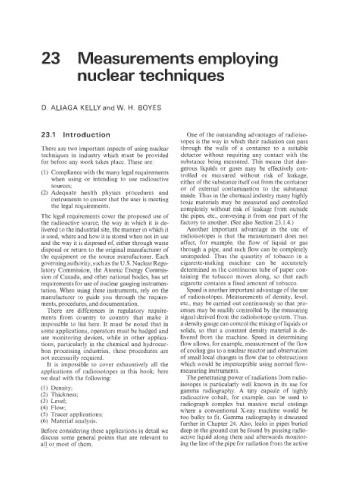Page 565 - Instrumentation Reference Book 3E
P. 565
23 Measurements employing
nuclear techniques
D. ALIAGA KELLY and W. H. BOYES
23.l Introduction One of the outstanding advantages of radioiso-
topes is the way in which their radiation can pass
There are two important aspects of using nuclear through the walls of a container to a suitable
techniques in industry which must be provided detector without requiring any contact with the
for before any work takes place. These are: substance being measured. This means that dan-
gerous liquids or gases may be effectively con-
(1) Compliance with the many legal requirements trolled or measured without risk of leakage,
when using or intending to use radioactive either of the substance itself out from the container
sources; or of external contamination to the substance
(2) Adequate health physics procedures and inside. Thus in the chemical industry many highly
imtruments to ensure that the user is meeting toxic materials may be measured and controlled
the legal requirements. completely without risk of leakage from outside
The legal requirements cover the proposed use of the pipes, etc., conveying it from one part of the
the radioactive source, the way in which it is de- factory to another. (See also Section 23.1.4.)
livered to the industrial site, the manner in which it Another important advantage in the use of
is used, where and how it is stored when not in use radioisotopes is that the measurement does not
and the way it is disposed of, either through waste affect, for example, the flow of liquid or gas
disposal or return to the original manufacturer of through a pipe, and such flow can be completely
the equipment or the source manufacturer. Each unimpeded. Thus the quantity of tobacco in a
governing authority, such as the U.S. Nuclear Regu- cigarette-making machine can be accurately
latory Commission, the Atomic Energy Commis- determined as the continuous tube of paper con-
sion of Canada, and other national bodies, has set taining the tobacco moves along, SO that each
requirements for use of nuclear gauging instrumen- cigarette contains a fixed amount of tobacco.
tation. When using these instruments, rely on the Speed is another important advantage of the use
manufacturer to guide you through the require- of radioisotopes. Measurements of density, level,
menis, procedures, and documentation. etc., may be carried out continuously so that pro-
There are differences in regulatory require- cesses may be readily controlled by the measuring
ments from country to country that make it signal derived from the radioisotope system. Thus:
impossible to list here. It must be noted that in a density gauge can control the mixing of liquids or
some applications, operators must be badged and solids, so that a constant density material is de-
use monitoring devices, while in other applica- livered from the machine. Speed in determining
tions, particularly in the chemical and hydrocar- flow allows, for example, measurement of the flow
bon processing industries, these procedures are of cooling gas to a nuclear reactor and observation
not necessarily required. of small local changes in flow due to obstructions
It is impossible to cover exhaustively all the which would be imperceptible using normal flow-
applications of radioisotopes in this book; here measuring instruments.
we deal with the following: The penetrating power of radiations from radio-
isotopes is particularly well known in its use for
(1) Density; gamma radiography. A tiny capsde of highly
(2) Thickness; radioactive cobalt, for example, can be used to
(3) Level; radiograph complex but massive metal castings
(4) 1:iow; where a conventiona! X-ray machine would be
(5) Tracer applications; too bulky to fit. Gamma radiography is discussed
(6) Material analysis. further in Chapter 24. Also, leaks in pipes buried
Before considering these applications in detail we deep in the ground can be found by passing radio-
discuss some general points that are relevant to active liquid along them and afterwards monitor-
all or most of them. ing the line of the pipe for radiation from the active

